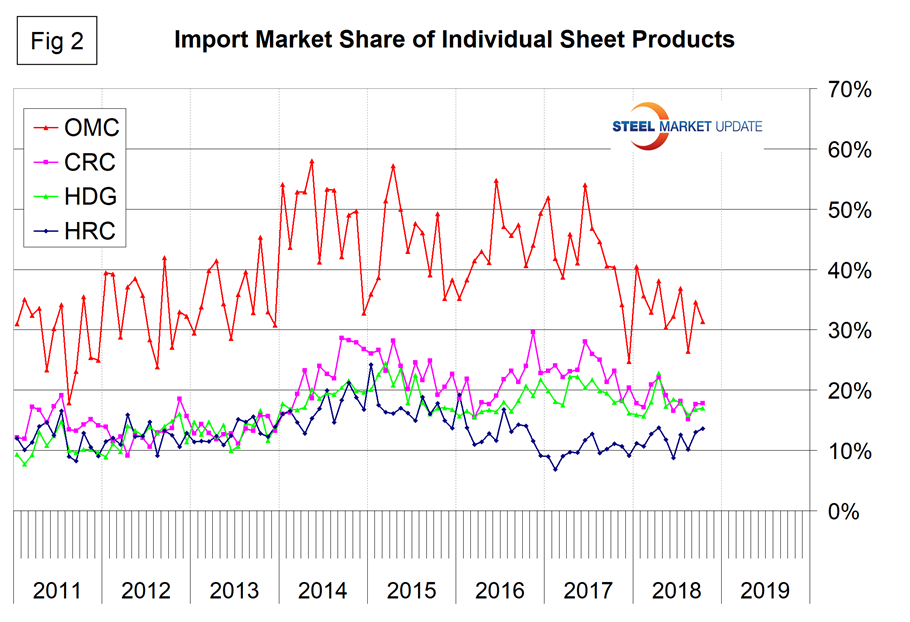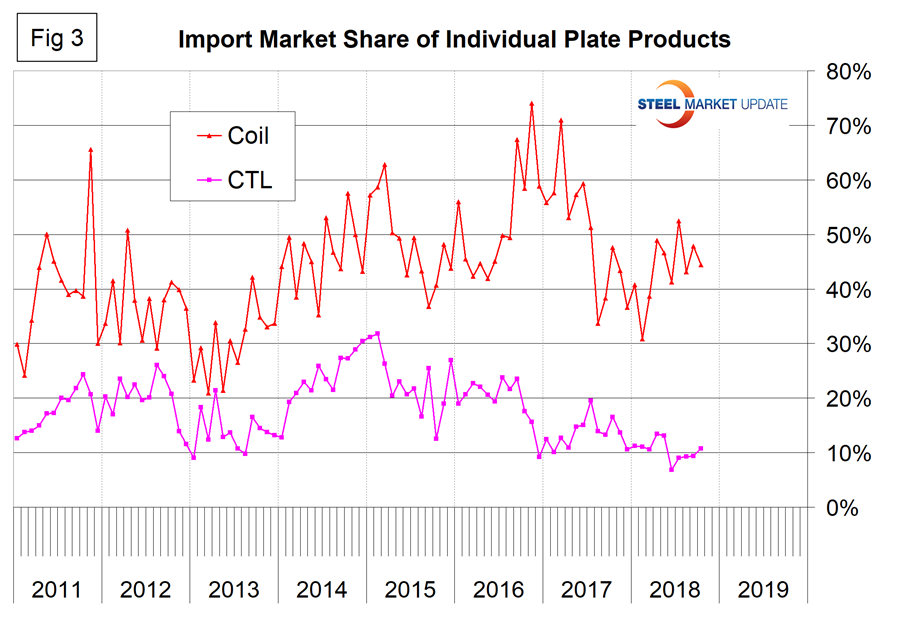Market Data

December 17, 2018
Steel Import Market Share Through October
Written by Peter Wright
This report examines the import share of sheet, plate, long and tubular products and 16 subcategories through October.
![]() Table 1 shows total supply to the market in three months through October and in 12 months through October for the four product groups and the 16 subcategories. Supply to the market is the total of domestic mill shipments to domestic locations plus imports. It shows imports on the same three- and 12-month basis and then calculates import market share for the two time periods for 16 products. Finally, it subtracts the 12-month share from the three-month share and color codes the result green or red. If the result of the subtraction is positive, it means that import share is increasing and the code is red. The big picture is that import market share declined in three months compared to 12 months for each of the four product groups and declined for all individual products except HR coil and plate in coil.
Table 1 shows total supply to the market in three months through October and in 12 months through October for the four product groups and the 16 subcategories. Supply to the market is the total of domestic mill shipments to domestic locations plus imports. It shows imports on the same three- and 12-month basis and then calculates import market share for the two time periods for 16 products. Finally, it subtracts the 12-month share from the three-month share and color codes the result green or red. If the result of the subtraction is positive, it means that import share is increasing and the code is red. The big picture is that import market share declined in three months compared to 12 months for each of the four product groups and declined for all individual products except HR coil and plate in coil.
There is a huge difference in import market share between products, with tubular goods and coiled plate being by far the worst cases. In the tubular section of Table 1, the import share of structural tubing is blank because source data for domestic production prior to October 2017 made no sense and we have not included it.

Figure 1 shows the historical import market share of plate and total sheet products. The import share of plate has been decreasing erratically for three years. There have been wide swings in the import share of sheet products, but in the last 24 months there hasn’t been much change overall.

Figure 2 shows the import market share of the four major sheet products. Other metallic coated (mainly Galvalume) has by far the highest import market share and hot rolled has the lowest.

Figure 3 breaks out coiled and CTL plate from the flat rolled total and shows that coil imports currently have over four times the market share of CTL imports.

Figure 4 describes the total import share of tubular goods and long products. It is evident, as we work the numbers, that data for the domestic production of tubulars is much less reliable than for other products. Domestic shipments are definitely understated for some products, and we suspect for all. This is probably because of a more fragmented supply chain and the independent tubers not reporting to the extent that the steel mills do for other products. This has the result of increasing the apparent import market share. The import market share of long products has decreased from almost 30 percent to little more than 10 percent in the last 18 months.

Figure 5 shows the import market share of the individual tubular products. Based on the available information, all are very high compared to other steel product groups and line pipe is the highest.

Figure 6 shows the detail for the four major sectors of the long product group. The most significant reduction is for wire rod, which in the years 2014 through 2017 had a significantly higher import market share than the other long products. In 2018, the gap has narrowed. The import share of hot rolled bars and structural shapes has declined strongly this year. Rebar has been erratic, and in October imports had a similar share to the same time last year.








